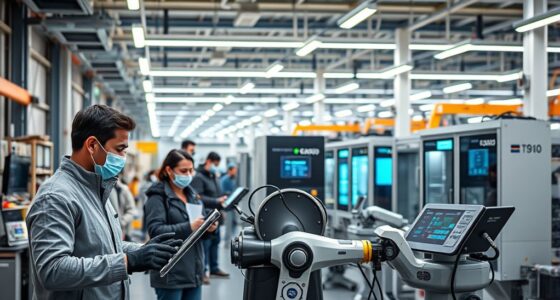Robotic surgeons are advancing healthcare, but nurses aren’t losing out; their roles are evolving. While robots improve precision and reduce complications, human expertise remains essential for patient care, pre- and post-surgical tasks, and managing robotic systems. Nurses now need additional training to work seamlessly with these technologies. If you want to learn how this technological shift impacts nurses’ roles and what the future holds, there’s more to explore.
Key Takeaways
- Nurses play a crucial role in robotic surgeries, handling preoperative prep and postoperative care, ensuring their continued importance.
- Skilled operators are essential; human oversight remains vital for safety, preventing nurses from losing their roles.
- Nurses may require additional training to work effectively with advanced robotic systems, enhancing their responsibilities.
- The growth of robotic surgery increases the need for multidisciplinary teamwork, emphasizing nurses’ integral role.
- Technological advancements aim to complement, not replace, nurses, maintaining their critical contribution in patient care.

Robot surgeons are transforming healthcare by offering greater precision and efficiency in the operating room. The global surgical robotics market was valued at about USD 65 billion in 2022 and is expected to nearly double by 2030, reaching USD 119.7 billion. This rapid growth reflects the increasing adoption of robotic systems across hospitals worldwide. You’ll notice that the use of robotic surgery has jumped from 1.8% to 15.1% for general procedures, with smaller hospitals (under 200 beds) leading the charge. Interestingly, about 85% of teaching hospitals have already integrated robotic techniques, highlighting their importance in modern medical training and practice. The adoption rate among hospitals continues to accelerate, driven by technological advancements and proven clinical benefits. The integration of robotics in surgery also encourages ongoing innovation in medical devices and software solutions.
Robotics enhance surgical precision, which translates into shorter recovery times and better patient outcomes. When these systems incorporate AI, the benefits grow even more. AI-assisted surgeries can reduce operative times by 25% and cut complication rates by nearly a third. These systems offer real-time feedback and intraoperative video analysis, markedly decreasing the risk of errors. They can adapt during procedures, minimizing trauma and postoperative issues. Digital twins—virtual replicas of patients—allow surgeons to simulate surgeries beforehand, anticipate potential complications, and improve overall safety. These technological advances make surgeries safer and more predictable, benefiting both patients and medical teams.
Robotics and AI boost surgical precision, reducing risks and improving safety through real-time feedback and virtual patient simulations.
Economically, the market for surgical robots is booming. By 2025, projections suggest the market may surpass current estimates, driven by the rising demand for minimally invasive procedures. The growth rate for robotic surgical devices is expected to hover around 13.4% annually from 2024 to 2025. By then, simulation platforms will dominate over 74% of the market for robotic surgery training, underscoring the importance of simulation in skill development. The overall expansion is fueled by patient preferences for less invasive options, but the high costs of robotic systems still pose a challenge for some healthcare providers.
As for the human element, robots are not autonomous—they require skilled surgeons and expert operators. You’ll find that robotics isn’t universally suitable across all specialties; some doctors find it slows them down or doesn’t fit their workflow. Nurses play a pivotal role in robotic surgeries, handling preoperative preparations and postoperative care, roles that are unlikely to be replaced by machines. To work effectively with robotic systems, nurses might need additional training, emphasizing teamwork and communication in the operating room. Despite the technological leap, human involvement remains essential, especially in ensuring patient safety and providing comprehensive care. Additionally, ongoing research into robotic-assisted procedures continues to expand the capabilities and safety protocols associated with this technology.
While smaller hospitals tend to adopt robotic surgery more quickly, overall, the trend indicates that robotics will become increasingly integrated into healthcare. The growing adoption doesn’t threaten the fundamental roles nurses play; instead, it highlights the need for collaboration and adaptation. Your skills as a nurse are essential in this evolving landscape, supporting surgeons and ensuring smooth, effective surgeries.
Frequently Asked Questions
How Do Robot Surgeons Impact Patient Recovery Times?
You might wonder how robot surgeons affect patient recovery times. They generally shorten hospital stays by about 20%, helping you get back to normal faster. With less blood loss, fewer complications, and lower readmission rates, your recovery can be smoother and quicker. While some patients experience discomfort or longer recovery depending on their case, overall, robotic surgery aims to improve your recovery experience and reduce time away from daily activities.
What Training Is Required for Nurses to Work Alongside Robot Surgeons?
You need specialized training to work alongside robot surgeons. This includes mastering robotic system operation, understanding equipment setup, and learning patient positioning for robotic procedures. You’ll also develop skills in assisting with suturing, managing risks, and collaborating within interdisciplinary teams. Your training involves online modules, hands-on workshops, and competency assessments to guarantee you’re prepared. Ongoing education and team feedback help you stay current, improve safety, and advance your career in robotic surgery.
Are Robot Surgeons More Cost-Effective Than Traditional Surgery?
You might think robotic surgeons are just about high costs, but they can be more cost-effective long-term. Despite higher initial expenses, you benefit from shorter hospital stays, quicker recoveries, and better outcomes. As case volumes grow and technology advances, costs decrease. So, while the upfront investment is steep, you and your patients could see savings and improved quality of life, making robotic surgery a smarter choice over time.
How Do Patients Feel About Robotic-Assisted Surgeries?
You probably wonder how patients feel about robotic-assisted surgeries. They generally have positive opinions, with 85% reporting better outcomes like less pain and quicker recovery. Many recommend robotic procedures over manual ones, especially for knee replacements, citing increased comfort and natural movement. Patients trust these surgeries more after experiencing fewer complications and shorter hospital stays, which boosts their overall satisfaction and confidence in robotic technology.
What Are the Ethical Considerations of Replacing Human Surgeons With Robots?
When considering replacing human surgeons with robots, you need to weigh ethical issues carefully. You must guarantee accountability for robotic errors, protect patient privacy, and maintain beneficence by preventing harm. Fair access and avoiding disparities matter too. Transparency in how robots operate and involving patients in informed decisions are vital. You should also consider the risks of AI and autonomous systems, ensuring technology benefits all without compromising safety or ethical standards.
Conclusion
As robot surgeons become more prevalent, you might wonder how this will impact nurses. Imagine a future where over 70% of surgeries are performed with robotic assistance—your role could shift towards more patient care and coordination. While technology advances, remember that your expertise remains essential. Embracing these changes means you’ll adapt and thrive, ensuring patients get the best care possible. The future isn’t replacing nurses—it’s transforming the healthcare landscape, and you’re central to that evolution.









